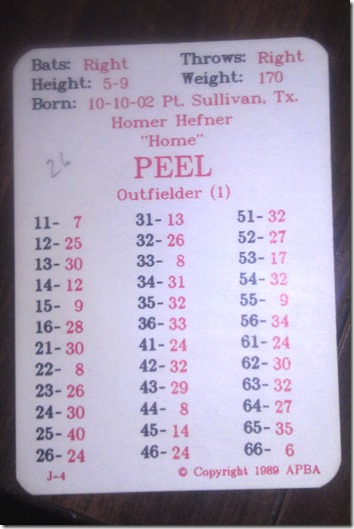I’m not used to seeing 1930 cards on Tuesday. They’re quite the favorite on Monday.
The inaptly-named Homer Peel played for three teams in the National League between the years of 1927 and 1934. In those years, he did manage one “homer” in 1933. However, he couldn’t knock one out in 1930, the year this card is based on.
“Home”, as we was apparently called, didn’t do much of anything else that year with the St Louis Cardinals either. He hit .164 and slugged only .192.
| Split | G | GS | PA | AB | R | H | 2B | 3B | HR | RBI | SB | BB | SO | |||
|---|---|---|---|---|---|---|---|---|---|---|---|---|---|---|---|---|
| 1930 Totals | 26 | 16 | 77 | 73 | 9 | 12 | 2 | 0 | 0 | 10 | 0 | 3 | 4 | .164 | .197 | .192 |
Anytime a player gets an automatic fly out at 51, they’re considered a candidate for Terrible Card Tuesday. No need for an interview. Step right up.
Peel did get a 66-6 based on two doubles in 77 plate appearances. One other nice feature of Peel’s card is his 31-13. It’s the only one on the card. While that may be low for four strikeouts, he has a full set of 33 and 34, plus a couple 27s. He’s sure to get his four somewhere via pitchers strikeout letters.
Peel also gets an added bonus of four 24s should there happen to be a runner on first base.
A little piece of Homer Peel trivia: Peel was involved in a deal with 20-game loser Bob McGraw. Both were traded by the Phillies to St Louis for Hall of Famer Grover Cleveland “Pete” Alexander and Harry McCurdy (who wasn’t too bad as a backup catcher). Alexander was way past his prime of course and went 0-3 in 9 games for Philadelphia that next year.
Peel didn’t do much better. He went on to bat a couple hundred at-bats in the following five years. His best year was in 1933 when he hit .257 in 148 at-bats.




